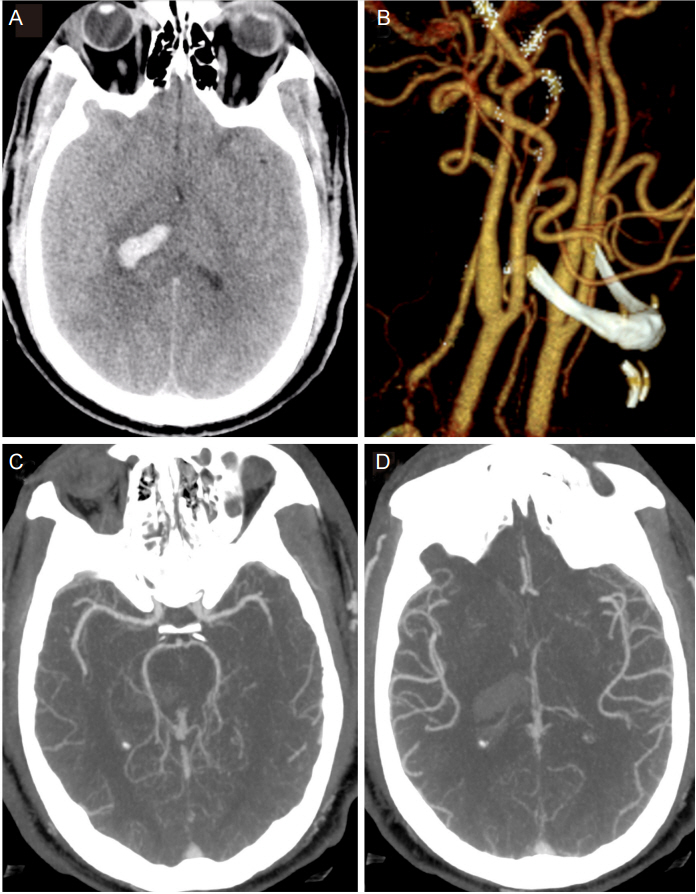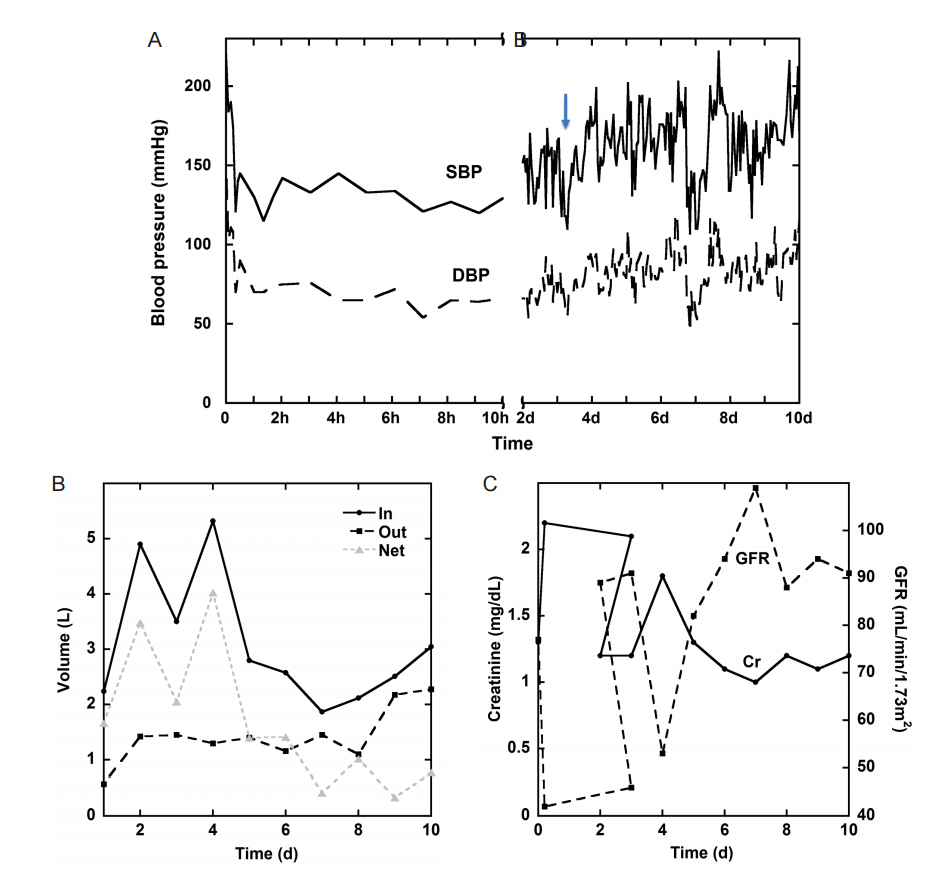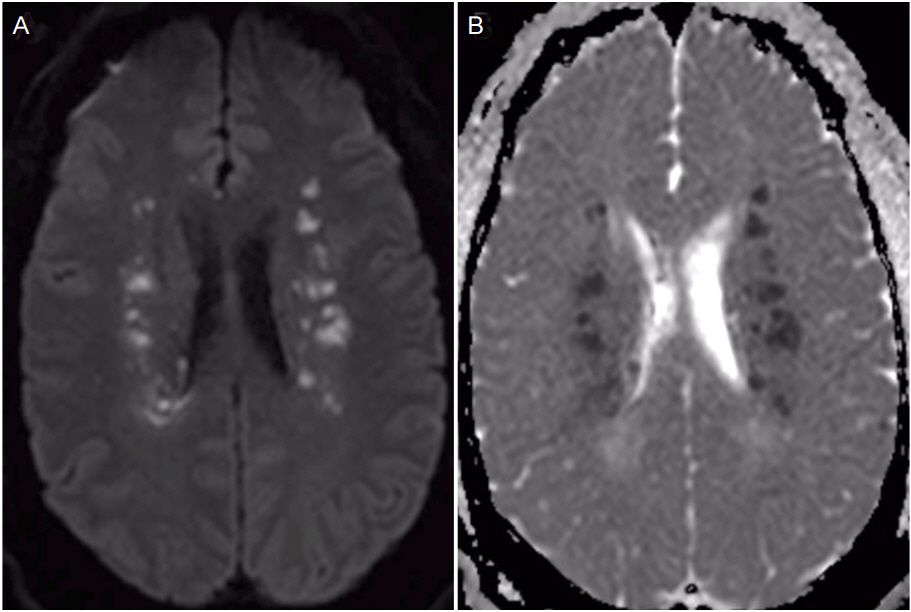J Neurocrit Care.
2017 Jun;10(1):36-40. 10.18700/jnc.160102.
Adverse Effects of Aggressive Blood Pressure Control in Patients with Intracerebral Hemorrhage
- Affiliations
-
- 1Department of Neurological Surgery, University of Virginia Health System, Charlottesville, VA, USA. pm5mt@virginia.edu
- 2Department of Radiology & Medical Imaging, University of Virginia Health System, Charlottesville, VA, USA.
- 3Department of Neurology, University of Virginia Health System, Charlottesville, VA, USA.
- KMID: 2385885
- DOI: http://doi.org/10.18700/jnc.160102
Abstract
- BACKGROUND
Medical management of patients presenting with spontaneous intracerebral hemorrhage (ICH) is focused on blood pressure (BP) management. However, the BP goal to prevent ICH expansion remains controversial. Recent clinical trials have suggested that aggressive BP control is safe but may not have the previously thought benefits.
CASE REPORT
We present an example of aggressive BP control in the setting of hypertensive ICH, in accordance to previously established protocols. This resulted in adverse effects in the form of acute kidney injury and watershed infarcts, which impeded the patients' recovery and prolonged his hospitalization.
CONCLUSIONS
Hypertensive individuals have altered cerebral autoregulation curves shifted to the right and require higher arterial pressures to maintain adequate cerebral blood flow. Hence, aggressive BP reduction may result in cerebral hypoperfusion as well as other forms of end-organ damage.
MeSH Terms
Figure
Reference
-
1. Hemphill JC 3rd, Greenberg SM, Anderson CS, Becker K, Bendok BR, Cushman M, et al. Guidelines for the Management of Spontaneous Intracerebral Hemorrhage: A Guideline for Healthcare Professionals From the American Heart Association/American Stroke Association. Stroke. 2015; 46:2032–60.
Article2. Dandapani BK, Suzuki S, Kelley RE, Reyes-Iglesias Y, Duncan RC. Relation between blood pressure and outcome in intracerebral hemorrhage. Stroke. 1995; 26:21–4.
Article3. Qureshi AI. The Importance of Acute Hypertensive Response in ICH. Stroke. 2013; 44:S67–S9.
Article4. Anderson CS, Heeley E, Huang Y, Wang J, Stapf C, Delcourt C, et al. Rapid blood-pressure lowering in patients with acute intracerebral hemorrhage. N Engl J Med. 2013; 368:2355–65.
Article5. Hemphill JC 3rd, Bonovich DC, Besmertis L, Manley GT, Johnston SC. The ICH score: a simple, reliable grading scale for intracerebral hemorrhage. Stroke. 2001; 32:891–7.6. Qureshi AI, Palesch YY, Barsan WG, Hanley DF, Hsu CY, Martin RL, et al. Intensive Blood-Pressure Lowering in Patients with Acute Cerebral Hemorrhage. N Engl J Med. 2016; 375:1033–43.
Article7. Muiesan ML, Salvetti M, Amadoro V, di Somma S, Perlini S, Semplicini A, et al. An update on hypertensive emergencies and urgencies. J Cardiovasc Med (Hagerstown). 2015; 16:372–82.
Article8. Blumenfeld JD, Laragh JH. Management of hypertensive crises: the scientific basis for treatment decisions. Am J Hypertens. 2001; 14:1154–67.
Article9. Brooks TW, Finch CK, Lobo BL, Deaton PR, Varner CF. Blood pressure management in acute hypertensive emergency. Am J Health Syst Pharm. 2007; 64:2579–82.
Article10. Katz JN, Gore JM, Amin A, Anderson FA, Dasta JF, Ferguson JJ, et al. Practice patterns, outcomes, and end-organ dysfunction for patients with acute severe hypertension: the Studying the Treatment of Acute hyperTension (STAT) registry. Am Heart J. 2009; 158:599–606.e1.
Article11. Donnelly J, Budohoski KP, Smielewski P, Czosnyka M. Regulation of the cerebral circulation: bedside assessment and clinical implications. Crit Care. 2016; 20:129.
Article
- Full Text Links
- Actions
-
Cited
- CITED
-
- Close
- Share
- Similar articles
-
- Mirror-Image Intracerebral Hemorrhage in Basal Ganglia: Case Report
- The Risk Facotr Associated with Hypertensive Intracerebral Hemorrhage
- Etiology and Pathogenesis of Hypertensive Intracerebral Hemorrhage
- Recurrent and Repeated Hypertensive Intracerebral Hemorrhage in Surgically Treated Cases
- Correlation of changes of intracranial pressure and clinical manifestations in spontaneous intracerebral hemorrhage




